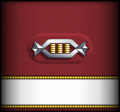Post by Captain Alexander Kynes on Feb 4, 2007 8:20:38 GMT
OBERTH CLASS


Type: Science vessel
Length: 120 meters
Decks: 13
Crew: 5 to 80
Defenses: Deflector shields
The Oberth-class was a type of mid-sized Federation starship used as a scout, science vessel, or Supply ship by Starfleet and civilian scientists alike, from the mid-23rd to the late-24th century.
History
Named in honor of the German rocket pioneer Hermann Oberth and was in use by the 2280s. The Oberth-class was designed and used almost exclusively for the study of stellar phenomena, including data gathering missions on stars and planets.
By the late 2360s these vessels served various roles in limited capacities, such as transports and Supply ships. They would be slowly phased out in the 2370s following the introduction of the more advanced Nova-class science vessel. (VOY: "Equinox")
Technical data
Despite its limited defenses, the Oberth-class starship was a highly valuable and adaptable class of vessel to the United Federation of Planets; it fulfilled a role that followed up on discoveries made by, and freeing up the resources of, the capital ships of the fleet.
Physical arrangement
MSD of an Oberth-class.In overall size, the Oberth-class is among the smallest long-range starships in the fleet.
The outboard plan of the Oberth's design incorporates a unique split hull design, with an upper primary hull that is composed mainly of the saucer section, which is mounted onto a rear extension that mounts the impulse drive, and warp drive nacelles to either side to the saucer. The secondary hull is connected to the primary hull at the nacelles by reinforced pylons. The secondary hull itself has a oblong shape.
Special features
Shielding
As a science vessel, Oberth-class starships are designed with specialized shields, which allow them to push through gravitational wavefronts. In conjunction with this feature, the interior bulkheads are composed of victurium alloy to better facilitate shielding. (TNG: "Hero Worship")
Escape pods
Oberth-class starships are also equipped with escape pods, having a minimum compliment of two. (TNG: "The Pegasus", "Realm of Fear")
Some Oberth-class starships, such as the USS Pegasus served as prototype for testing advanced starship technologies. The Pegasus was outfitted with an experimental engine and new weapon systems, some of which were used in the designs for Galaxy class starships. In addition to this, the Pegasus was the prototype for a Federation cloaking device. (TNG: "The Pegasus")
Due to the ulterior motive Admiral Pressman had, in terms of covering up the true nature of the importance of the Pegasus, it is possible that the ship may not have necessarily been used as a testbed for the Galaxy-class. Despite this, the timeframe that the Pegasus was operating in was during a period that the Galaxy-class was still being designed, making his comments at least plausible.
Crew Complement
An Oberth-class ship had an standard crew complement of approximately eighty, but was capable of operating with a crew of as few as five to seven.
Main Bridge
Forward port section of the Grissom bridge. Communications station, located on the starboard section of the Grissom bridge. With a blown emergency hatch.Located on Deck 1 of the saucer section, the Main Bridge houses the command center of the Oberth-class. The design lineage of the main bridge of an Oberth is fairly standard floor plan for a Federation starship. However, due to the ship's smaller size and subsequently smaller bridge, this class vessel featured only a single turbolift.
Located in the front was the viewscreen, with side-by-side navigator and helm consoles, which are in contrast positioned opposite to the arrangement found aboard Constitution-class starships. The captain's chair is directly aft of the aforementioned stations.
At the rear of the bridge, was the turbolift-entryway. The primary stations, which were located at either side of the captain's chair included a primary science station to port (pictured, right) with secondary stations trailing along the wall towards the back of the bridge. Along the starboard side of the bridge in the communications station.
An access way to the the Bridge is also located on the aft section of the ship, through the secondary airlock. This access way is located one bulkhead away from the Bridge. (TNG: "Interface") A 24th century bridge variation also included an emergency hatch set in the bulkhead, which could be used to escape from the bridge, into space, during an emergency situation.
The bridge of the Grissom was a redress of the bridge of the USS Enterprise, altered only slightly to reflect the smaller size of the class. Among the more notable changes are the reupholstered chairs and the placement of center console.
The bridge of the Tsiokovsky was described simply as a "small bridge". The set was, itself, only a partial, containing a few chairs and consoles, dominated by the view of the open emergency hatch.
Main Engineering
Main engineering.Main Engineering is where the ship's power systems are controlled and home of the ship's antimatter warp drive chamber and impulse engine controls.
Corridors
A typical corridor design.Because of its small size, many of the corridors double as auxiliary access points to various parts of the ship.
Access to the computer core is also made from a corridor-like chamber that is designed with a couple of science consoles and small monitors against the wall.
The anteroom, just outside the bridge is located at the end of a corridor. This section contains a viewscreen-monitor and the ship's dedication plaque.
Science Ops
Section of the ship dedicated to scientific study. It contains a transporter pad. (TNG: "Realm of Fear")
Personnel Quarters
Crew quarters found aboard the Oberth-class were not unlike those found aboard other Federation starships. They included a main living area, with an attached bedroom and adjacent bathroom.


Type: Science vessel
Length: 120 meters
Decks: 13
Crew: 5 to 80
Defenses: Deflector shields
The Oberth-class was a type of mid-sized Federation starship used as a scout, science vessel, or Supply ship by Starfleet and civilian scientists alike, from the mid-23rd to the late-24th century.
History
Named in honor of the German rocket pioneer Hermann Oberth and was in use by the 2280s. The Oberth-class was designed and used almost exclusively for the study of stellar phenomena, including data gathering missions on stars and planets.
By the late 2360s these vessels served various roles in limited capacities, such as transports and Supply ships. They would be slowly phased out in the 2370s following the introduction of the more advanced Nova-class science vessel. (VOY: "Equinox")
Technical data
Despite its limited defenses, the Oberth-class starship was a highly valuable and adaptable class of vessel to the United Federation of Planets; it fulfilled a role that followed up on discoveries made by, and freeing up the resources of, the capital ships of the fleet.
Physical arrangement
MSD of an Oberth-class.In overall size, the Oberth-class is among the smallest long-range starships in the fleet.
The outboard plan of the Oberth's design incorporates a unique split hull design, with an upper primary hull that is composed mainly of the saucer section, which is mounted onto a rear extension that mounts the impulse drive, and warp drive nacelles to either side to the saucer. The secondary hull is connected to the primary hull at the nacelles by reinforced pylons. The secondary hull itself has a oblong shape.
Special features
Shielding
As a science vessel, Oberth-class starships are designed with specialized shields, which allow them to push through gravitational wavefronts. In conjunction with this feature, the interior bulkheads are composed of victurium alloy to better facilitate shielding. (TNG: "Hero Worship")
Escape pods
Oberth-class starships are also equipped with escape pods, having a minimum compliment of two. (TNG: "The Pegasus", "Realm of Fear")
Some Oberth-class starships, such as the USS Pegasus served as prototype for testing advanced starship technologies. The Pegasus was outfitted with an experimental engine and new weapon systems, some of which were used in the designs for Galaxy class starships. In addition to this, the Pegasus was the prototype for a Federation cloaking device. (TNG: "The Pegasus")
Due to the ulterior motive Admiral Pressman had, in terms of covering up the true nature of the importance of the Pegasus, it is possible that the ship may not have necessarily been used as a testbed for the Galaxy-class. Despite this, the timeframe that the Pegasus was operating in was during a period that the Galaxy-class was still being designed, making his comments at least plausible.
Crew Complement
An Oberth-class ship had an standard crew complement of approximately eighty, but was capable of operating with a crew of as few as five to seven.
Main Bridge
Forward port section of the Grissom bridge. Communications station, located on the starboard section of the Grissom bridge. With a blown emergency hatch.Located on Deck 1 of the saucer section, the Main Bridge houses the command center of the Oberth-class. The design lineage of the main bridge of an Oberth is fairly standard floor plan for a Federation starship. However, due to the ship's smaller size and subsequently smaller bridge, this class vessel featured only a single turbolift.
Located in the front was the viewscreen, with side-by-side navigator and helm consoles, which are in contrast positioned opposite to the arrangement found aboard Constitution-class starships. The captain's chair is directly aft of the aforementioned stations.
At the rear of the bridge, was the turbolift-entryway. The primary stations, which were located at either side of the captain's chair included a primary science station to port (pictured, right) with secondary stations trailing along the wall towards the back of the bridge. Along the starboard side of the bridge in the communications station.
An access way to the the Bridge is also located on the aft section of the ship, through the secondary airlock. This access way is located one bulkhead away from the Bridge. (TNG: "Interface") A 24th century bridge variation also included an emergency hatch set in the bulkhead, which could be used to escape from the bridge, into space, during an emergency situation.
The bridge of the Grissom was a redress of the bridge of the USS Enterprise, altered only slightly to reflect the smaller size of the class. Among the more notable changes are the reupholstered chairs and the placement of center console.
The bridge of the Tsiokovsky was described simply as a "small bridge". The set was, itself, only a partial, containing a few chairs and consoles, dominated by the view of the open emergency hatch.
Main Engineering
Main engineering.Main Engineering is where the ship's power systems are controlled and home of the ship's antimatter warp drive chamber and impulse engine controls.
Corridors
A typical corridor design.Because of its small size, many of the corridors double as auxiliary access points to various parts of the ship.
Access to the computer core is also made from a corridor-like chamber that is designed with a couple of science consoles and small monitors against the wall.
The anteroom, just outside the bridge is located at the end of a corridor. This section contains a viewscreen-monitor and the ship's dedication plaque.
Science Ops
Section of the ship dedicated to scientific study. It contains a transporter pad. (TNG: "Realm of Fear")
Personnel Quarters
Crew quarters found aboard the Oberth-class were not unlike those found aboard other Federation starships. They included a main living area, with an attached bedroom and adjacent bathroom.
 Captain
Captain
